

Home > Travel > Yellowstone 2000
10/14 | 10/15
 |
||

Home > Travel > Yellowstone 2000 10/14 | 10/15 |
||
Mammoth Hot Springs, Norris Basin, Lower Basin Saturday, 10/14/2000 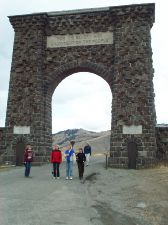
It's a truly international group that piles backpacks, bags and thick coats in our minivan's trunk on the campus of The University of Montana, Missoula: Petra and Sanna from Finland, Tasia from Denmark, Marie from Sweden, Gabe from Montana and Matthias from Germany. Shortly after 9 a.m., we set the cruise control to 75 mph and go east on the Interstate Highway I-90. We are headed for Yellowstone National Park, the first national park of the world. 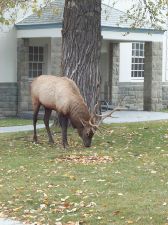
With the Clark Fork River to the right, the highway winds between the brightly fall-colored hills covered in strands of fog. It is a fresh morning, fair with some clouds. As we pass Deer Lodge, Anaconda and Butte, Gabe points out sights along the road: Montana's state prison, the remains of the world's largest smokestack, signs of strip mining... After about four hours, we reach the campus of Montana State University at Bozeman where we pick up Nils from Germany. We continue on the I-90 until Livingston, where we take the Highway 89 towards Gardiner. A giant brick gate marks the North Entrance to Yellowstone National Park. The engravings "For the benefit and enjoyment of the people" - "Created by act of Congress March 1, 1872" remind us of the historic discussions on what to do with this extraordinary landscape that preceded the establishment of Yellowstone's status as a national park. We had been told we'd probably see animals in the park, but we sure didn't expect to see two large deer right on the visitor center's lawn, staring lazily at the excited tourists fumbling with their cameras. 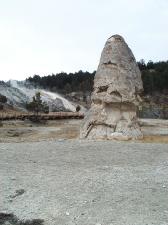
Our first stop is Mammoth Hot Springs. The Liberty Cap, an about five meter high cone of rock, marks the entrance to the thermal area. Here, mineral-rich water from hot springs has created huge terraces made of travertine. As hot water rises from underground through the rock, large quantities of limestone are dissolved and deposited at the surface when the water cools down, building the terraces. While travertine is normally a white material, bacteria that thrive in the hot water form large orange-brownish mats covering the surfaces. The terraces constantly grow where hot water flows over them and erode where the supply of water stops, thereby slowly changing shape over time. At the Palette Spring, we see the dead branches of bushes that have been embedded in the stone. Since the air temperature is only a few degrees above the freezing point, clouds of steam rise from the hot water, giving us a good whiff of sulfur everytime we pass through them. At this time of the year, a large part of the area, including Main Terrace and Jupiter Terrace, is dry with the travertine crust gray and broken. However, water is pouring down the slope of Canary Spring at the very end of the boardwalk system that runs through the area, creating a chaotic, yet oddly geometric pattern of terraces - some white, some with dark green, brown, orange or yellow streaks.
Back in our van, we try the American way of sightseeing for a change: Shortly after Mammoth Hot Springs, we turn into a scenic road - a convenient one-way loop road that takes us past many small terraces such as the New Highland Terrace, the Orange Spring Mound or the White Elephant Back Terrace. We enjoy the ride mostly because it takes us through a forest covered with a thin layer of snow, giving the steaming terraces an even more eerie look. 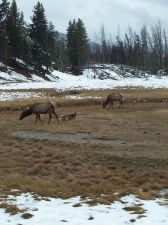
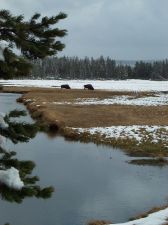
Returning to the main road, we head for Norris. On our way, we again see deer (up close) and bison (in the distance). Norris is a big geyser basin, partly forest, partly deserted plains. With a confirmed age of at least 115,000 years, it is the oldest geothermal area in Yellowstone - and also the hottest: A scientific drill measured a temperature of 237 °C (459 °F) just 326 meters (1,087 feet) below the surface. Consequently, most features in the basin are above the boiling point of water. We first visit the Porcelain Basin which looks like a huge scorched bowl surrounded by partly burned forest. Then, we hike around the back basin. After nearly every bend in the path, there is a new geyser, hot spring or other thermal feature. Some are nestled between the snowy trees, noticable only because of the rising plumes of steam or a soft hissing or gurgling sound, others are gaping holes in the barren ground, venting steam or filled with quiet or bubbling water. Their names are as colorful as their appearance: Palpitator Spring, Pearl Geyser, Porkchop Geyser, Yellow Funnel Spring, Phillips Cauldron... 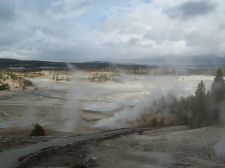
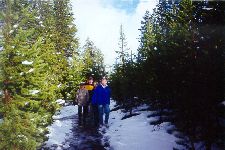
Given how obsessed Americans are with safety warnings, we're surprised how few of them we see in Yellowstone. Apart from the occasional tiny "Keep out - geothermal area" signs, there are no notices discouraging people from diving head first into hot springs - not even at the inviting Bathtub Spring. Of course, everybody is tempted to throw snowballs into the first hot spring we see, lying only a few feet away from the boardwalk. Some succeed and feel kind of bad when they see the notice at the next geyser saying it was irreparably congested by people throwing objects into its mouth.
Most of the geysers in the Norris Basin are only small and unpredictable. One of the bigger ones is the Echinus Geyser which is unpredictable on some days but predictable on others. In predictable periods, it's supposed to erupt every 30 to 40 minutes. Since there are some people sitting on benches around the crater, telling us they've been waiting for ten minutes, we stick around a bit, looking at the quiet blue pool disrupted only by bubbles surfacing in some spots. Most waters in Norris are acidic, and Echinus Geyser actually has a pH value of about 3.5. A busy nearby steam vent blankets half of the benches with thick, sulfuric-smelling clouds. After ten more minutes, we lose our patience (generally not a good idea in Yellowstone, but hey, we're here for two days only) and move on to the next sight - Steamboat Geyser. With eruptions of 100-133 meters (300-400 feet), this is the world's tallest geyser, but unfortunately, it is also totally unpredictable. Steamboat's largest recorded eruption was in the 1950's, and its last major eruption was on May 5, 2000. According to a nearby sign, indicators of an impending major eruption are continuing two-meter-high bursts of water - and indeed at the very moment we turn to move on, some water jets come from the crater. Excited, we stay a few minutes more, but the geyser is quiet again except for the constantly billowing plumes of steam that gave it its name. 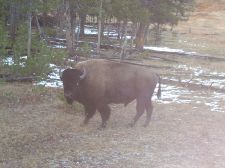
We continue on the main road to Madison and from there head towards Old Faithful. Since the sky is getting grayer by the minute and dusk is setting in, we skip most of the sights on the way to save them for the next day. Unfortunately, we miss the entrance to the Firehole Canyon Drive. This is a one-way side road that departs from the main road just south of Madison after the bridge over Gibbon River, goes by Firehole Falls and then meets the main road again. However, we do take the Firehole Lake Drive, another side road in the Lower Geyser Basin that takes us to the Great Fountain Geyser. With jets reaching between 33 and 66 meters (100-200 feet), this is one of Yellowstone's bigger geysers. Great Fountain erupts twice a day, but predictions are issued with a tolerance of two hours. We go around the geyser crater on a boardwalk, but the steam is so dense we can barely make out the surface of the water or see the wooden planks ten meters ahead of us. All we can hear is venting and bubbling sounds coming from somewhere inside the white cloud. We reach Old Faithful Village in complete darkness. After dropping our stuff at the Snow Lodge, we tour the shops and restaurants, looking for something to eat. Finally, we reserve a table at the Old Faithful Lodge Dining Room. We have to wait about 1.5 hours before we can get in, which is not so cool, but we get a cordless pager to summon us to our table, which is quite cool - or rather, "dope shit, yo" as Gabe teaches us while we wait in the bar, sampling American beer and sketching Yellowstone postcards on paper napkins. Conversation soon revolves solely around sophisticated (i.e., British) vs. slang (i.e., Montanan/Missoulian) English, broadening our vernacular considerably. When our pager finally goes off blinking and buzzing and scaring the hell out of Marie who had used it as a drink coaster, we move to the dining room. Picking up the conversation from the bar, we keep getting strange side looks from the people around us - to the embarassment of Gabe because "I'm the only one speaking decent English here so I don't have an excuse for not respecting American customs as opposed to you European guys." Still, we have a hilarious time and a good, not too expensive meal with burgers and lots of bread (thanks to Sanna). At about 11 p.m., we return to the Snow Lodge Cabin to stay for the night. |